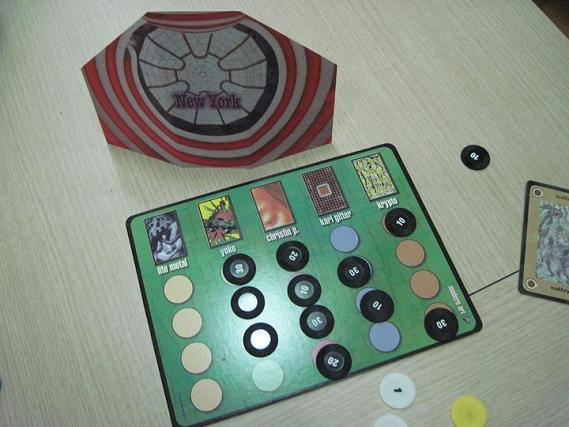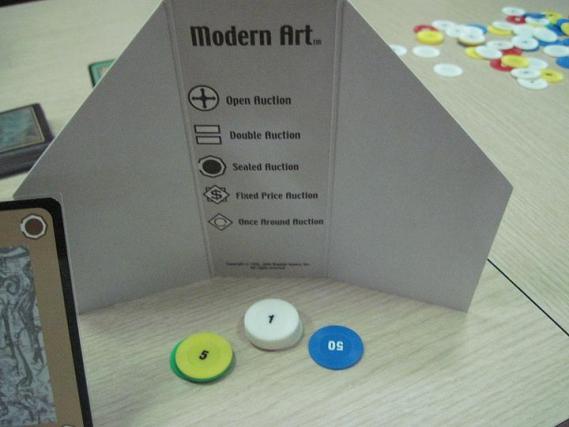22 Mar

I’m amused by how many complaints there seem to be about the bad art in the game. Hey, it’s modern art, it’s supposed to be bad!
Oddly enough, of all the Knizia games I’ve played, the auction games stick out the most for me because at least in their case the mechanics match up with the theme. Okay, Ra is still a bit weird, but both High Society and Modern Art are light games with relatively simple rules that intuitively reflect their subject matter very well. Some quick notes about the theme and the rules that I find amusing:
- It’s a game about auctioning piece of modern art, yet it doesn’t use real-world artist and artworks, which is a bit disappointing. Obviously the issue is licensing. Getting permission to use pictures of real-life examples of modern art would be prohibitively expensive and no self-respecting artist would want their work to be associated with a board game like this anyway. But they could at least make them more recognizable parodies of existing works.
- Knizia could have gotten around this by using images of classic art, changing the theme, but perhaps he consciously intended this game to be a critique of modern art? After all, prices of well-known classic works don’t fluctuate that much. Perhaps Knizia meant to use this game’s mechanics to point out how some artists in the modern art become fashionable and have the value of their work go up to stratospheric heights simply because of the hype? Then after a while the hype dies down and they could become worthless.
- This is the first time I’ve seen so many auction types in a single game. Very cool! The double auction seems to be extremely powerful however, giving whoever draws it incredible power to influence the value placements. Unless you have a double of your own, it doesn’t seem possible to fight against it.

Hot artists get all the attention while uncool ones are neglected. It’s hard to fight against the market.
From our session:
- Chee Wee won the game because the rest of us were far too conservative about bidding. It seems to be pretty hard to make a set of paintings completely worthless other than in the very first round of offers. You’d need to fight against all the other players. This means that almost all sold paintings will have some minimum expected value, depending on whether they end up as the first, second or third most valuable set.
- Theoretically, this means as long as you aren’t losing money, you should bid as much as necessary to get the painting. Yet we tended not to do this so many paintings went for perhaps fifty to sixty percent what they might be worth at the end of the season, making them much more profitable for the buyer than the seller.
- Like all auction games, money is secret information and it’s kind of important to keep a rough track of how much money each player has, so you can let people who are behind you earn a bit more and try not to let the people ahead of you earn more from a deal than what you’re earning yourself. I really suck at this as I’m lazy about memorizing stuff.
- I went into this game thinking about Traders of Genoa in which I did okay by being careful with my spending while Sean did badly by always buying an action even if it was very expensive. In retrospective, this was the wrong mindset to take because expected returns from the paintings are much more predictable than the expected value of an action in Traders of Genoa.

The handy screen shows all the different auction types which are definitely not equal. Double auctions are incredibly powerful while open auctions make the most money consistently.
Written on March 22 2011 and is filed under Boardgames.
You can follow any responses to this entry through the RSS 2.0 feed.
You can leave a response, or trackback from your own site.
Leave a Reply